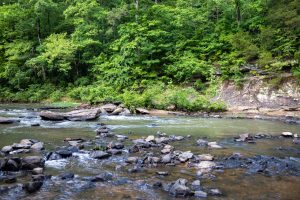
From the 2021 Collegian | In the heart of Tuscaloosa County, a small stream runs through the woods. Here, frogs hop from stone to stone, insects and butterflies flutter about, and water transports fish and other river dwellers downstream. Locals spend their days on the creek’s banks, swimming, hiking, and adventuring in their own backyard.
This stream is known as Hurricane Creek, a tributary of the Black Warrior River. A landmark to Tuscaloosa natives, Hurricane Creek has long been a favorite place to spend the afternoon. But it’s also home to a diverse ecosystem—one that, without help from the public, could become unhealthy.
Dr. Julia Brock, an assistant professor of history, and Jamey Grimes, an assistant professor of art and art history, want to help Hurricane Creek’s patrons, as well as patrons of the Black Warrior watershed as a whole, gain a deeper understanding of the environmental issues surrounding the creek’s ecosystem through their project, Flow Tuscaloosa.
Brock and Grimes, who are both fellows in the Collaborative Arts Research Initiative, or CARI, decided to collaborate after CARI directors Rebecca Salzer and Michelle Bordner saw that they both wanted to bring environmental issues to the community through an arts-based project. After meeting, they realized they had similar ideas about the execution—a lantern parade.
“Lanterns are beautiful,” Grimes said. “Everybody loves a lantern. It’s interesting that we can even do things like just put lights on the trees that are already there, and find a way to see them a little bit differently for just a moment. And so we want to find a way not to hijack nature and turn it into something different, but to just get people to notice, for a moment, what they typically walk past on a regular basis.”
The lanterns will be created through Flow Tuscaloosa workshops in city and county schools and in the community, with help from the Friends of Hurricane Creek, UA’s geography department, the UA map library, and the Arts and Humanities Council of Tuscaloosa. Throughout the workshops, the lantern-makers will learn more about Hurricane Creek and the Black Warrior River watershed.
“We want to bring folks together and talk about the creek,” Brock said. “We’ll talk about the human and natural history of the creek, and the ecology of the creek. And then ideally, they’ll build lanterns that represent the health of the creek—something like a mayfly, which is an indicator species that says the creek is healthy, or an aspect of the watershed’s history.”
The lanterns will make their public debut at the parade, which will take place on the Tuscaloosa Riverwalk. Brock and Grimes hope that this will bring lantern-makers from different workshops together, connecting the community through a shared learning experience.
“We want to provide educational opportunities that are fun, and as hands-on as possible,” Grimes said. “And our guests to our workshops would hopefully attend the parades. So the idea is that they’re going to be there not just as a visitor at a parade, but really, as an active participant. It’s all about bringing people together that typically might not actually interact as much as they would otherwise. We’re looking for ways that people can have more common ground.”
With the knowledge learned from the workshops and the sense of community garnered from the parade, Brock and Grimes hope that visitors will gain a stronger sense of pride and ownership over the Black Warrior watershed in Tuscaloosa. They also hope to bring light to environmental justice issues and initiatives in West Alabama.
“We were inspired by the Creekkeeper of Hurricane Creek, John Wathen,” Brock said. “And in some ways, we’re trying to encourage another kind of “keeping”—the keeping of place for the Tuscaloosa community and beyond. We’re hoping to not only render the natural environment more visible, but the historical narratives of place more visible, so we can encourage the kind of stewardship that comes with place-keeping.”
In addition to the lantern workshops and parade, Brock and Grimes are working with the Selvage Collective to create installations that represent histories of and human connections to our waterways. Selvage, made of Teresa Bramlette Reeves, Kirstie Tepper, and Brock herself, is a curatorial collective focused on using art to reveal alternative narratives to historical events. The installations will take place at the Mildred Warner Westervelt Transportation Museum, the Paul R. Jones Museum, and the UA Gallery in the Dinah Washington Cultural Arts Center and will feature artists Tony Bingham, Boo Gilder, Michi Meko, Kelly Taylor Mitchell, and Hannah S. Palmer.
The installation is supported in part by an Our Town grant from the National Endowment for the Arts, which funds projects that strengthen community through arts and culture. In 2021, only 63 projects across the nation received these grants. For Brock and Grimes, the Our Town grant shows just how important this project is to preserving not only the Black Warrior watershed but creating a community in Tuscaloosa.
The Flow Tuscaloosa workshops are set to begin in Spring 2022, with the lantern parade capping off the end of the spring semester. The installations will open in spring and summer of 2022. For more information, visit their website. If you’d like to get involved, email Julia Brock or Jamey Grimes.